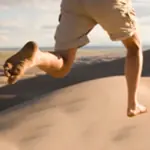A common myth we have all heard floating around at one time or
another is that running will "ruin your knees." This is even stated by some well-meaning
medical practitioners despite the lack of scientific evidence. In fact, studies suggest that if anything,
runners are less likely to develop debilitating hip or knee osteoarthritis when
compared to a more sedentary population (ref 1 & 2).
That said, many runners do suffer with knee pain at some point in
their running careers. This month I hope
to direct your attention to a few common causes of knee pain and broadly
discuss their remedies. Let me preface
the rest of this article by saying for most knee pain caused by activity, the
official diagnosis isn’t particularly helpful.
It’s the medical version of Juliet’s monologue on the balcony, “what’s
in a name?” she says! Whether you have
tendonitis, tendonosis, a partial tear of something, iliotibial band syndrome,
or you ate too much cake last night…the key in recovering is finding the
dysfunction.
Problem #1 - Hip and/or ankle stiffness
The ball and socket joint of our hips provide our lower
extremities with a great deal of motion and adaptability. Likewise, our feet and ankles are paramount
in adapting to our running surface. If
either of these areas lack proper range of motion, it's not uncommon for this
imbalance to manifest itself as knee pain.
Because the hips and/or foot/ankle complex is not moving correctly, the
knee will take excess stress. Your
practitioner should always check your hip, ankle, and foot for restrictions if
you present to them with knee pain. Once
you understand the problem, the remedy is quite intuitive, improve range of
motion and practice basic exercises to ensure the muscles of the hip, ankle,
and foot are working properly.
Problem #2 - A lack of pelvic and core control
This problem is a bit more insidious and often more difficult to
self-test. Essentially, many of us have
muscle imbalances involving our spines and pelvis. Some of these imbalances may occur because we
sit too much or we over-train one movement or activity. Most adults do not move in novel ways unless
they are actively engaged in a movement practice or have a job that requires
many different types of activities (i.e. When was the last time you did a cart-wheel?).
Ultimately, the muscles throughout our trunk (core) must
coordinate with the muscles in our hips to provide a stable pelvis when
running. If we are not coordinating
things correctly we may find that we have chronic back, hip, knee, or even ankle/foot
pain. The coordination process is quite
complicated but thankfully the remedy is usually much more simple. In the same way that one learns to throw a
baseball or play the violin, we can break down the basic movements of the spine
and pelvis, testing each one until we find a lack of integrity.
On slow motion analysis, a lack of pelvic or core control can
manifest itself in a loss of alignment in the spine, pelvis, knees, and the
ankle/foot. It is usually most evident
in the mid-stance phase, when all of the body weight is rested on a single
leg. It is at this point we usually see
a break down of control.
 |
| If my pelvis dramatically loses alignment (drops in mid-stance), my entire lower extremity and spine will have to compensate. Here we see a mostly level pelvis which allows the knee to stay aligned between the hip and foot. |
 |
| On the other hand, a hip drop will cause compensation somewhere else in the body. This gentleman is leaning his trunk to maintain balance and may also be increasing injury in the lower extremity. Notice his left foot (behind him) is crossing towards the right leg which further identifies the hip drop. |
Problem #3 - A lack of foot control
In our world of overly-cushioned shoes and high-priced orthotics,
most runners today lack proper foot function.
It is a self-fulfilling prophecy to say that people need motion control
shoes because they have never learned to control their own foot motion. On slow-motion running gait analysis, the
same pitfalls seen with poor pelvic control can be caused by a lack of foot
control. In fact, unless a practitioner
tests both areas, they won't know which is causing the problem. Often it is best to treat control and
coordination issues globally because we know that everything has to work
together to produce a healthy running gait.
Problem #4 - Over-striding or slow cadence
I have discussed this topic in the past but suffice to say
over-striding or running with a slow cadence (<160 steps-per-minute) is
highly associated with more impact force through the lower extremity. Greater impact forces are associated with
more lower extremity injuries to include knee pain. Strength training and plyometric drills can
help to improve force output, meaning, it is easier for us to run and maintain
a healthier, more efficient cadence. Poor
force output resembles the ultra-shuffle while a high-force output can be seen
in sprinters and excellent long-distance runners (Eliud Kipchoge anyone?).
 |
| Over-striding is equivalent to "braking" when running. Ideally our feet will land closer to our center of mass. |
Problem #5 – Doing too much too soon
We are all aware of this rule in exercise but I’m mentioning it
anyway. Because you could be doing
everything else right but you’re doing more exercise than your body can adapt
to within a given time frame. Remember
that exercise is a stress to the body and can depress our immune systems and
cause injury when taken far beyond our current abilities. The key to avoid this pitfall is to ask
yourself before your workout, can I actually recover from this workout? If you’re not getting enough sleep, mobility
work, time spent relaxing, or good nutrition, you’re basically a ticking
time-bomb for something breaking down.
Whether you visit me in the office or you already have a trusted
practitioner, the path to healthy knees should include some sort of learning on
your part. I watch runners flock to
quick fixes because they do not understand their problem. But trust me, no human was born with a Hoka
or orthotic deficiency. If you're
anything like the modern human, you probably need a little more balance in your
life. Finding out the true cause should
be your aim. Whatever you do, don't give
up on running.
Ref 1:
Effects of Running and Walking on Osteoarthritis and Hip Replacement Risk. Med Sci Sports Exerc. 2013 Jul; 45(7): 1292–1297.
Ref 2: Long
Distance Running and Knee Osteoarthritis A Prospective Study. Am J Prev Med.
2008 Aug; 35(2): 133–138.




















